Preparation of Green Low Strength Mixture for Foundation Reinforcement Treatment by Using Fly Ash and Waste Coal Gangue
Abstract
1. Introduction
2. Experimental Details
2.1. Raw Materials
2.2. Mix Design and Specimen Preparation
2.3. Experimental Methods
2.3.1. Compressive Strength
2.3.2. Dynamic Elastic/Shear Modulus
2.3.3. Stress–Strain Curve Test
2.3.4. Durability Test
2.3.5. Green Degree Indices of FGM
3. Results and Discussion
3.1. Compressive Strength
3.2. Dynamic Modulus and Dynamic Poisson’s Ratio
3.3. Stress–Strain Relationship
3.4. Resistance to Acid Corrosion
3.4.1. Appearance of Corroded Specimens
3.4.2. Mass and Modulus Loss Rate of the Specimens
3.4.3. Strength Loss Rate
3.5. Greenness of FGM
3.5.1. Indices of e-CO2 and e-energy
3.5.2. Relationships Between Environmental Impact Indices of FGM and Compressive Strength
3.5.3. Designing High Performance and High Greenness FGM
- (1)
- Selection of the regional coal gangue makes high strength in FGM, such as the source from Changzhi in this experiment.
- (2)
- Ensuring a reasonable aggregate gradation by optimizing the ratio of fine aggregate to coarse aggregate. The optimal ratio is 3:7 in this experiment.
- (3)
- Determining a suitable ratio of fly ash to cement, the optimal ratio is around 1:1 in this study.
- (4)
- Keeping the low ratio of water to binder. It is suggested that the ratio should be no more than 0.6.
4. Conclusions
- The factors of coal gangue types, binder amount, aggregate gradation, water to binder ratio (w/b) and fly ash proportion can greatly influence the strength and durability of FGM. Decreasing w/b or fly ash proportion in the total binder will enhance strength and durability. Larger total binder content can do so. The “8-18” band aggregate gradation is an optimal mix to design FGM with the highest strength, while it cannot deteriorate the durability.
- Preparing FGM with below 0.6 of w/b and below 50% fly ash of total binder can product over 10 MPa strength in the material. When considering environmental influence, it should keep a certain cement content at low. Therefore, to design high durability FGM with green and cleaning, w/b should be reduced to below 0.6. Then, coal gangue I (from Xuchang) and coal gangue IV (from Yulin) are good raw materials to be selected.
- Regardless of the FGM mix proportion, the indices of e-CO2 and e-energy go down with the compressive strength increasing. However, it is suitable for FGM with a compressive strength ranging from 8–14 MPa. In the comparison of previous treatments for consolidating foundation, the significant advantage of FGM material has the lower energy consumption and smaller carbon emission in unit m3 preparation. However, it does not show much on CO2 exhausting reduction from unit MPa·m3 in FGM.
- Advices was provided for designing and preparing FGM with high quality and low carbon emissions. It can promote foundational technology with lower costs, greater sustainability, and an overall high environmental value.
Author Contributions
Funding
Acknowledgments
Conflicts of Interest
References
- Chen, F.-Q.; Lin, L.-B.; Wang, J.-J. Energy method as solution for deformation of geosynthetic-reinforced embankment on Pasternak foundation. Appl. Math. Model. 2019, 66, 424–439. [Google Scholar] [CrossRef]
- Yunus, N.Z.M. Performance of Lime-Treated Marine Clay on Strength and Compressibility Chracteristics. Int. J. GEOMATE 2015, 8, 1232–1238. [Google Scholar]
- Kang, G.; Tsuchida, T.; Athapaththu, A. Engineering behavior of cement-treated marine dredged clay during early and later stages of curing. Eng. Geol. 2016, 209, 163–174. [Google Scholar] [CrossRef]
- Kheradi, H.; Ye, B.; Nishi, H.; Oka, R.; Zhang, F. Optimum pattern of ground improvement for enhancing seismic resistance of existing box culvert buried in soft ground. Tunn. Undergr. Space Technol. 2017, 69, 187–202. [Google Scholar] [CrossRef]
- You, S.; Cheng, X.; Guo, H.; Yao, Z. Experimental study on structural response of CFG energy piles. Appl. Therm. Eng. 2016, 96, 640–651. [Google Scholar] [CrossRef]
- Xiaoluan, H. Construction and application analysis of CFG composite foundation of high-rise building in soft soil area. Guangdong Archit. Civ. Eng. 2019, 26, 40–42. (In Chinese) [Google Scholar]
- Xiao, D.; Jiang, G.; Liao, D.; Hu, Y.; Liu, X. Influence of cement-fly ash-gravel pile-supported approach embankment on abutment piles in soft ground. J. Rock Mech. Geotech. Eng. 2018, 10, 977–985. [Google Scholar] [CrossRef]
- Ren, Q.; De Schutter, G.; Jiang, Z.; Chen, Q. Multi-level diffusion model for manufactured sand mortar considering particle shape and limestone powder effects. Constr. Build. Mater. 2019, 207, 218–227. [Google Scholar] [CrossRef]
- Tang, Z.; Ke, G.; Li, W.; Tam, V.W.; Zhou, J.L. Sulfate attack resistance of sustainable concrete incorporating various industrial solid wastes. J. Clean. Prod. 2019, 218, 810–822. [Google Scholar] [CrossRef]
- Li, D.; Wu, D.; Xu, F.; Lai, J.; Shao, L. Literature overview of Chinese research in the field of better coal utilization. J. Clean. Prod. 2018, 185, 959–980. [Google Scholar] [CrossRef]
- Wang, S.; Luo, K. Atmospheric emission of mercury due to combustion of steam coal and domestic coal in China. Atmos. Environ. 2017, 162, 45–54. [Google Scholar] [CrossRef]
- Cheng, Y.; Hongqiang, M.; Hongyu, C.; Jiaxin, W.; Jing, S.; Zonghui, L.; Mingkai, Y. Preparation and characterization of coal gangue geopolymers. Constr. Build. Mater. 2018, 187, 318–326. [Google Scholar] [CrossRef]
- Guo, Y.; Zhang, Y.; Cheng, F. Industrial development and prospect about comprehensive utilization of coal gangue. CIESC J. 2014, 65, 2443–2453. [Google Scholar]
- Wang, J.; Ju, Y.; Wang, M.; Li, X. Scenario analysis of the recycled copper supply in China considering the recycling efficiency rate and waste import regulations. Resour. Conserv. Recycl. 2019, 146, 580–589. [Google Scholar] [CrossRef]
- Sun, Q.; Tian, S.; Sun, Q.; Li, B.; Cai, C.; Xia, Y.; Wei, X.; Mu, Q. Preparation and microstructure of fly ash geopolymer paste backfill material. J. Clean. Prod. 2019, 225, 376–390. [Google Scholar] [CrossRef]
- Wang, J.; Qin, Q.; Hu, S.; Wu, K. A concrete material with waste coal gangue and fly ash used for farmland drainage in high groundwater level areas. J. Clean. Prod. 2016, 112, 631–638. [Google Scholar] [CrossRef]
- Huang, M.; Huang, S.; Zeng, J.; Cheng, Y.; Lei, T. The effect of PH on leaching characteristics of gangue as roasbed material of express way. Environ. Eng. 2014, 32, 773–776. [Google Scholar]
- Dong, Z.; Xia, J.; Fan, C.; Cao, J. Activity of calcined coal gangue fine aggregate and its effect on the mechanical behavior of cement mortar. Constr. Build. Mater. 2015, 100, 63–69. [Google Scholar] [CrossRef]
- You, S.; Cheng, X.; Guo, H.; Yao, Z. In-situ experimental study of heat exchange capacity of CFG pile geothermal exchangers. Energy Build. 2014, 79, 23–31. [Google Scholar] [CrossRef]
- Long, G.; Li, L.; Li, W.; Ma, K.; Dong, W.; Bai, C.; Zhou, J.L. Enhanced mechanical properties and durability of coal gangue reinforced cement-soil mixture for foundation treatments. J. Clean. Prod. 2019, 231, 468–482. [Google Scholar] [CrossRef]
- Hou, L.; He, X.; Li, X.; Wang, S.; Zhao, L. Species composition and colonization of dark septate endophytes are affected by host plant species and soil depth in the Mu Us sandland, northwest China. Fungal Ecol. 2019, 39, 276–284. [Google Scholar] [CrossRef]
- Zhou, X. The Deteriorative Mechanics Properties Test of the CFG Pile in Polluted Surroundings. Master’s Thesis, Hunan University of Science and Techonology, Xiangtan, China, 2016. [Google Scholar]
- Shi, Y.; Long, G.; Ma, C.; Xie, Y.; He, J. Design and preparation of ultra-high performance concrete with low environmental impact. J. Clean. Prod. 2019, 214, 633–643. [Google Scholar] [CrossRef]
- Long, G.; Gao, Y.; Xie, Y. Designing more sustainable and greener self-compacting concrete. Constr. Build. Mater. 2015, 84, 301–306. [Google Scholar] [CrossRef]
- Linhao, L.; Guchangcheng, L.; Chaoneng, B.; Yuan, S.; Kunlin, M.; Shen, Z. Durability of Coal Gangue and Its Interfacial zone with Cement Stone Under Dry-Wet Cycles. Coal Eng. 2019, 51, 153–159. (In Chinese) [Google Scholar]
- Ma, C.; Zhao, B.; Long, G.; Sang, X.; Xie, Y. Quantitative study on strength development of earth-based construction prepared by organic clay and high-efficiency soil stabilizer. Constr. Build. Mater. 2018, 174, 520–528. [Google Scholar] [CrossRef]
- Ashraf, W.; Noor, M. Performance-Evaluation of Concrete Properties for Different Combined Aggregate Gradation Approaches. Procedia Eng. 2011, 14, 2627–2634. [Google Scholar] [CrossRef]
- ASTM C39/C39M-10. Standard Test Method for Compressive Strength of Cylindrical Concrete Specimens.; ASTM: West Conshohocken, PA, USA, 2010. [Google Scholar]
- Huang, G.; Ji, Y.; Li, J.; Hou, Z.; Dong, Z. Improving strength of calcinated coal gangue geopolymer mortars via increasing calcium content. Constr. Build. Mater. 2018, 166, 760–768. [Google Scholar] [CrossRef]
- Chen, P.; Zheng, W.; Wang, Y.; Chang, W. Creep model of high-strength concrete containing supplementary cementitious materials. Constr. Build. Mater. 2019, 202, 494–506. [Google Scholar] [CrossRef]
- Thomas, R.J.; Peethamparan, S. Alkali-activated concrete: Engineering properties and stress–strain behavior. Constr. Build. Mater. 2015, 93, 49–56. [Google Scholar] [CrossRef]
- Standard Test Method for Static Modulus of Elasticity and Poisson’s Ratio of Concrete in Compression; ASTM International: West Conshohocken, PA, USA, 2002; p. 4.
- Standard Test Method for Dynamic Young’s Modulus, Shear Modulus, and Poisson’s Ratio by Impulse Excitation of Vibration; ASTM International: West Conshohocken, PA, USA, 2009.
- Chatveera, B.; Lertwattanaruk, P. Evaluation of nitric and acetic acid resistance of cement mortars containing high-volume black rice husk ash. J. Environ. Manag. 2014, 133, 365–373. [Google Scholar] [CrossRef]
- Zhou, S.; Ma, C.; Long, G.; Xie, Y. A novel non-Portland cementitious material: Mechanical properties, durability and characterization. Constr. Build. Mater. 2020, 238. [Google Scholar] [CrossRef]
- Yang, X.; Liu, J.; Li, H.; Xu, L.; Ren, Q.; Li, L. Effect of triethanolamine hydrochloride on the performance of cement paste. Constr. Build. Mater. 2019, 200, 218–225. [Google Scholar] [CrossRef]
- Müller, H.S.; Haist, M.; Vogel, M. Assessment of the sustainability potential of concrete and concrete structures considering their environmental impact, performance and lifetime. Constr. Build. Mater. 2014, 67, 321–337. [Google Scholar] [CrossRef]
- Electrification Bureau, Z. China Railway Signal & Communication Co, Ltd. World Wide Web. Available online: http://en.crsc.cn/ (accessed on 1 January 2020).
- Dixit, M.K. Embodied energy analysis of building materials: An improved IO-based hybrid method using sectoral disaggregation. Energy 2017, 124, 46–58. [Google Scholar] [CrossRef]
- Turner, L.K.; Collins, F.G. Carbon dioxide equivalent (CO2-e) emissions: A comparison between geopolymer and OPC cement concrete. Constr. Build. Mater. 2013, 43, 125–130. [Google Scholar] [CrossRef]
- Teymen, A.; Kılıç, A.; Kilic, A. Effect of grout strength on the stress distribution (tensile) of fully-grouted rockbolts. Tunn. Undergr. Space Technol. 2018, 77, 280–287. [Google Scholar] [CrossRef]
- Bewick, R.; Kaiser, P.; Amann, F. Strength of massive to moderately jointed hard rock masses. J. Rock Mech. Geotech. Eng. 2018. [Google Scholar] [CrossRef]
- Rashid, K.; Ahmad, M.; Tahir, M.A. Influence of organic agents to compressive strength of cement mortar. Constr. Build. Mater. 2018, 175, 434–438. [Google Scholar] [CrossRef]
- Cho, Y.K.; Jung, S.H.; Choi, Y.C. Effects of chemical composition of fly ash on compressive strength of fly ash cement mortar. Constr. Build. Mater. 2019, 204, 255–264. [Google Scholar] [CrossRef]
- Noushini, A.; Aslani, F.; Castel, A.; Gilbert, R.I.; Uy, B.; Foster, S. Compressive stress-strain model for low-calcium fly ash-based geopolymer and heat-cured Portland cement concrete. Cem. Concr. Compos. 2016, 73, 136–146. [Google Scholar] [CrossRef]
- Da, B.; Yu, H.; Ma, H.; Tan, Y.; Mi, R.; Dou, X. Experimental investigation of whole stress-strain curves of coral concrete. Constr. Build. Mater. 2016, 122, 81–89. [Google Scholar] [CrossRef]
- Hu, J.; Wu, J. Mechanical properties and uni-axial compression stress-strain relation of recycled coarse aggregate concrete subjected to salt-frost cycles. Constr. Build. Mater. 2019, 197, 652–666. [Google Scholar] [CrossRef]
- Guo, Z. Concrete Strength and Constitutive Relation: Principle and Application; China Architecture and Building Press: Beijing, China, 2004. [Google Scholar]
- Jianming, Y.; Luming, W.; Cheng, J.; Dong, S. Effect of fly ash on the corrosion resistance of magnesium potassium phosphate cement paste in sulfate solution. Constr. Build. Mater. 2020, 237. [Google Scholar] [CrossRef]
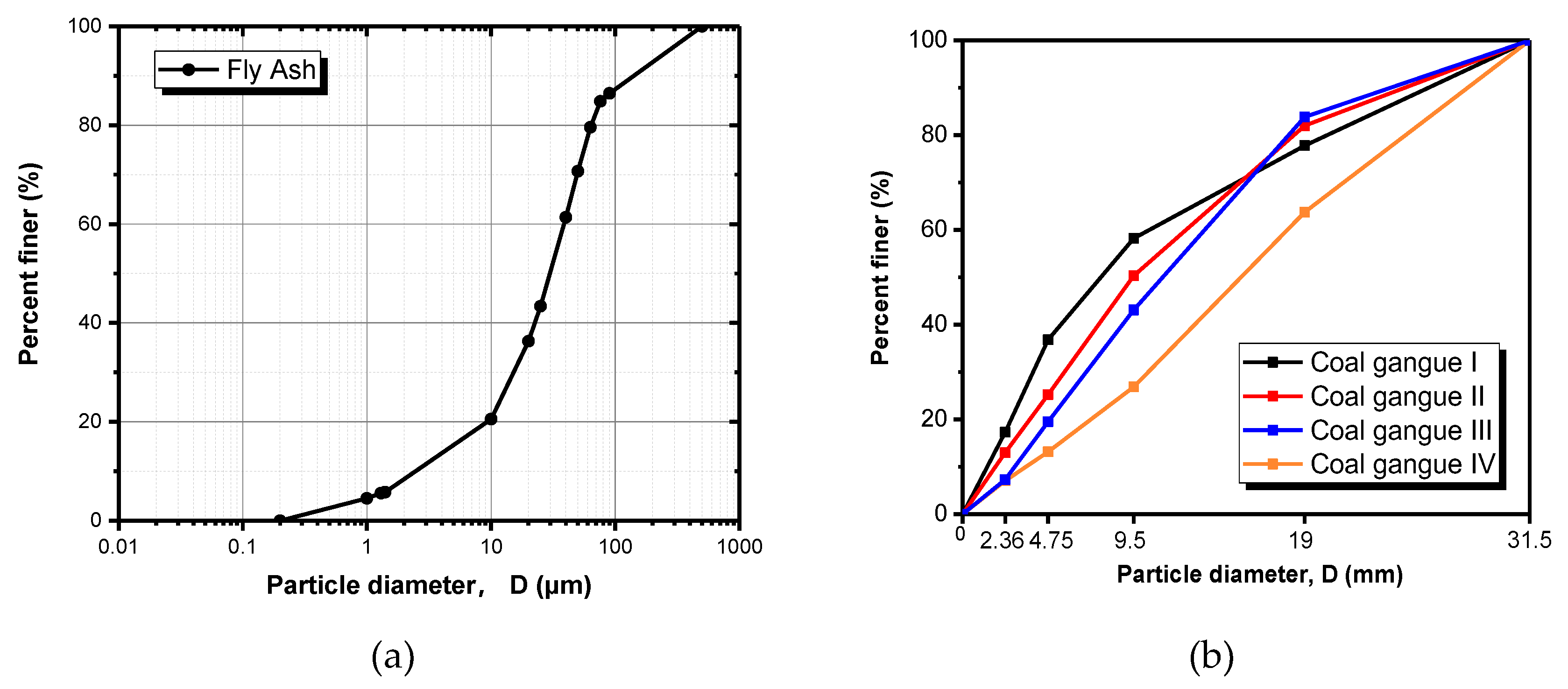
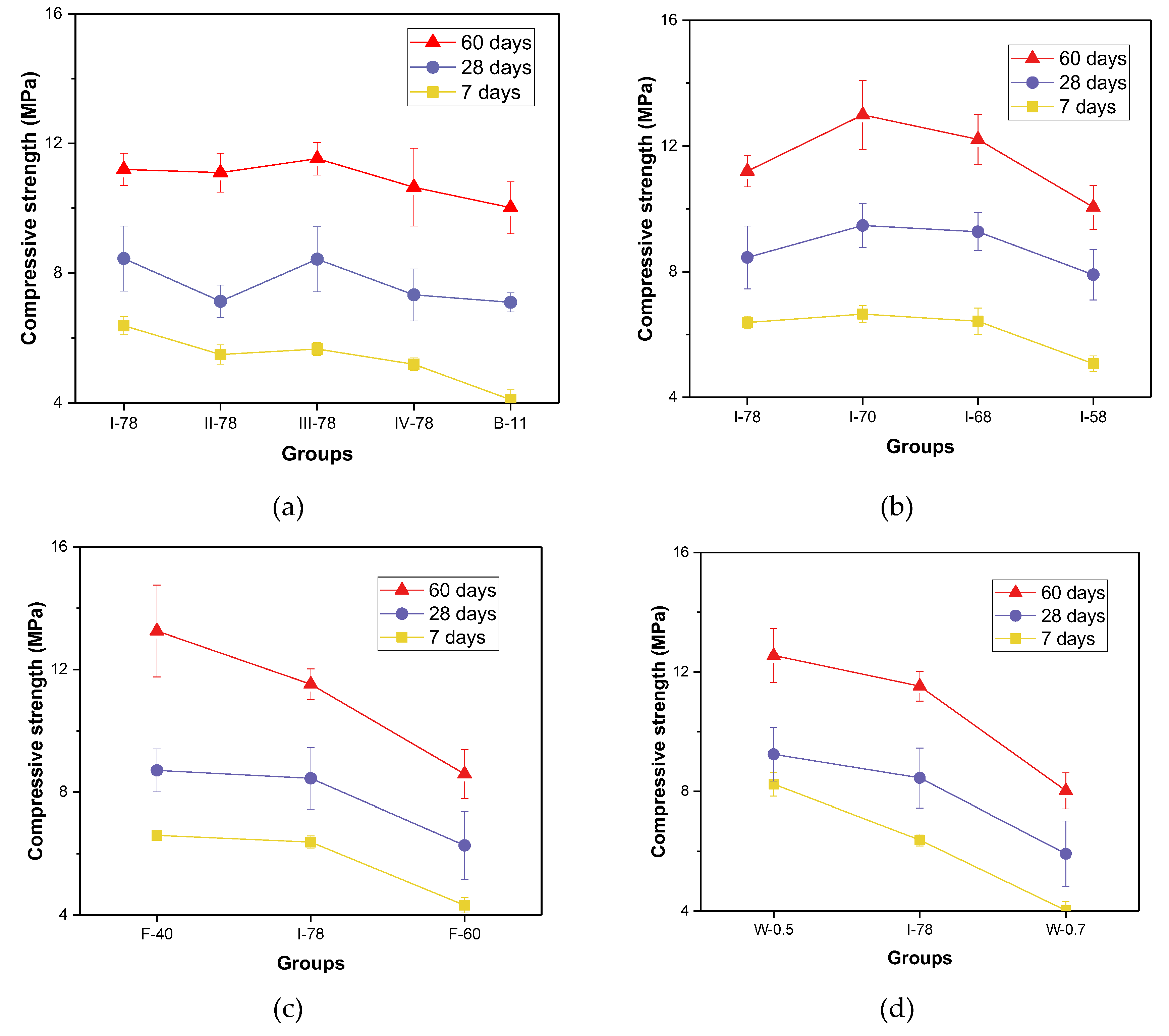
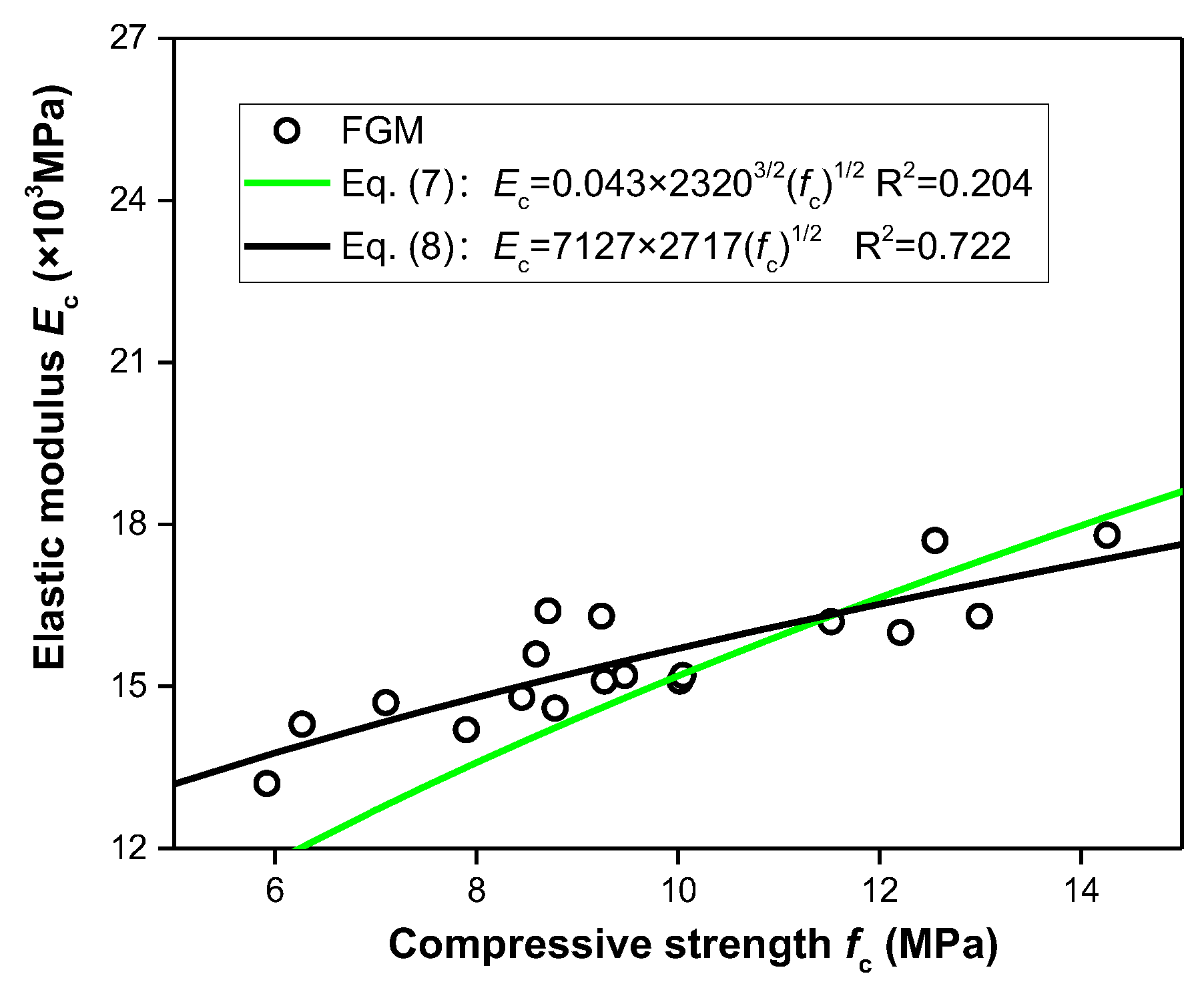
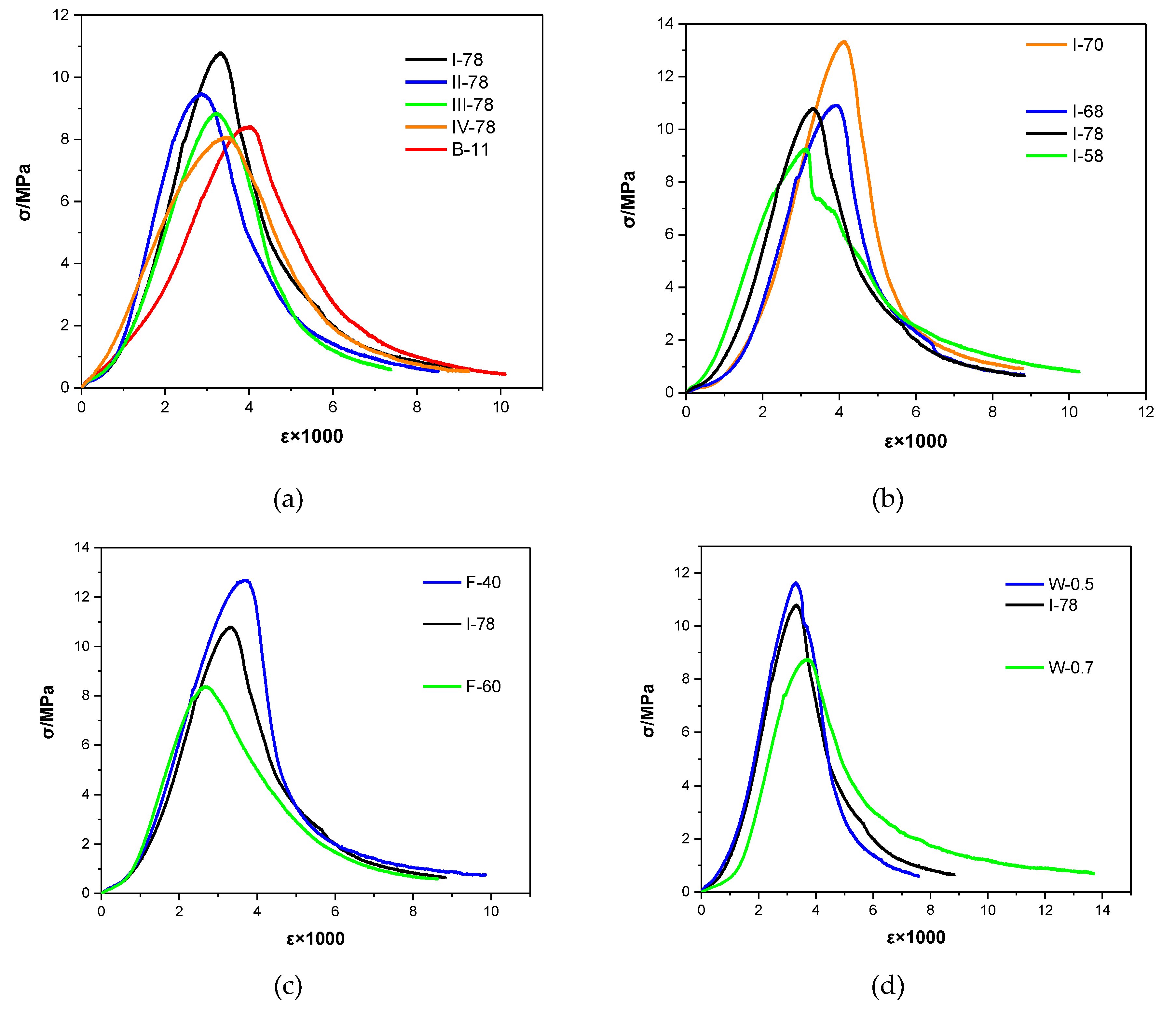
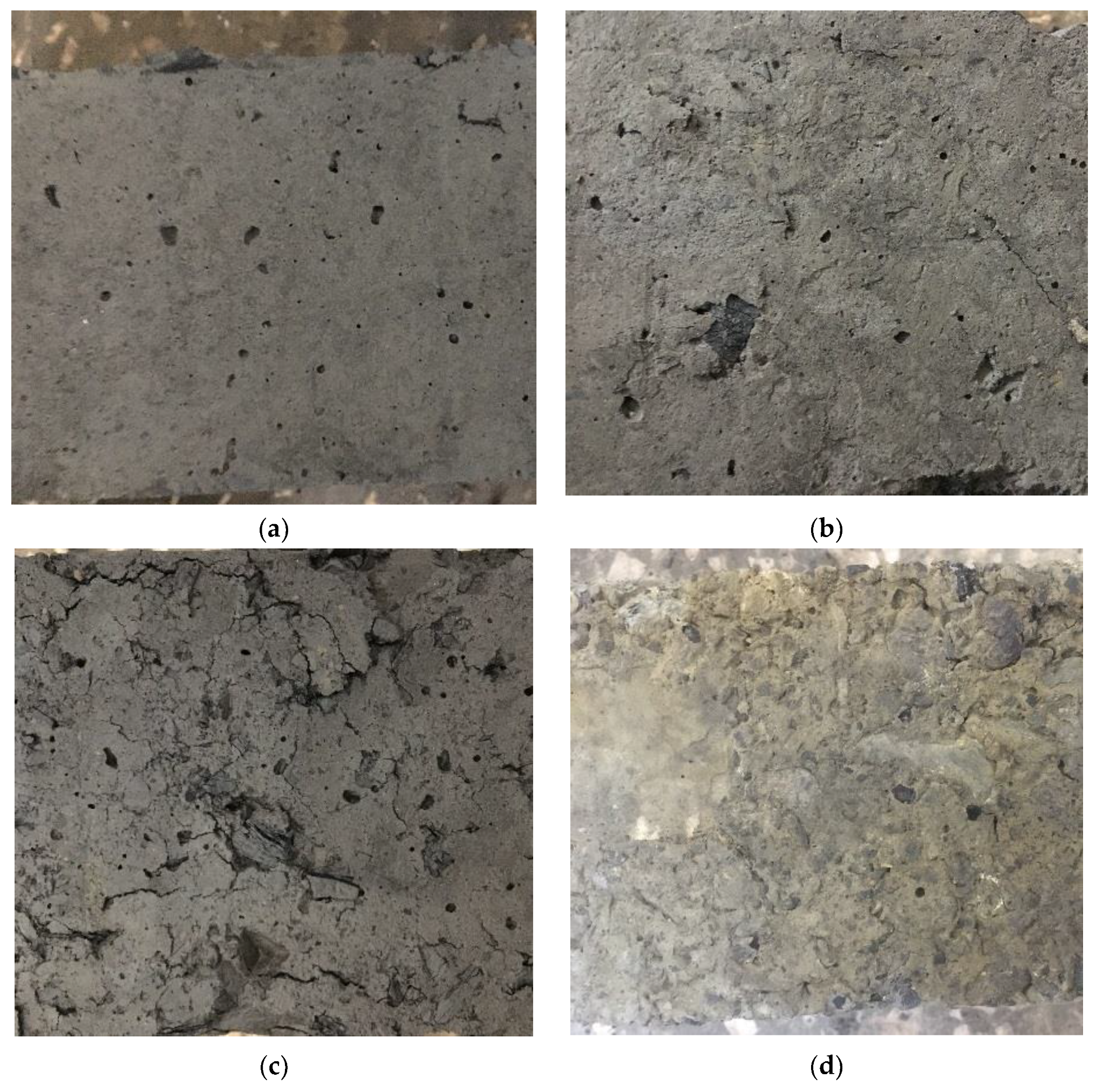
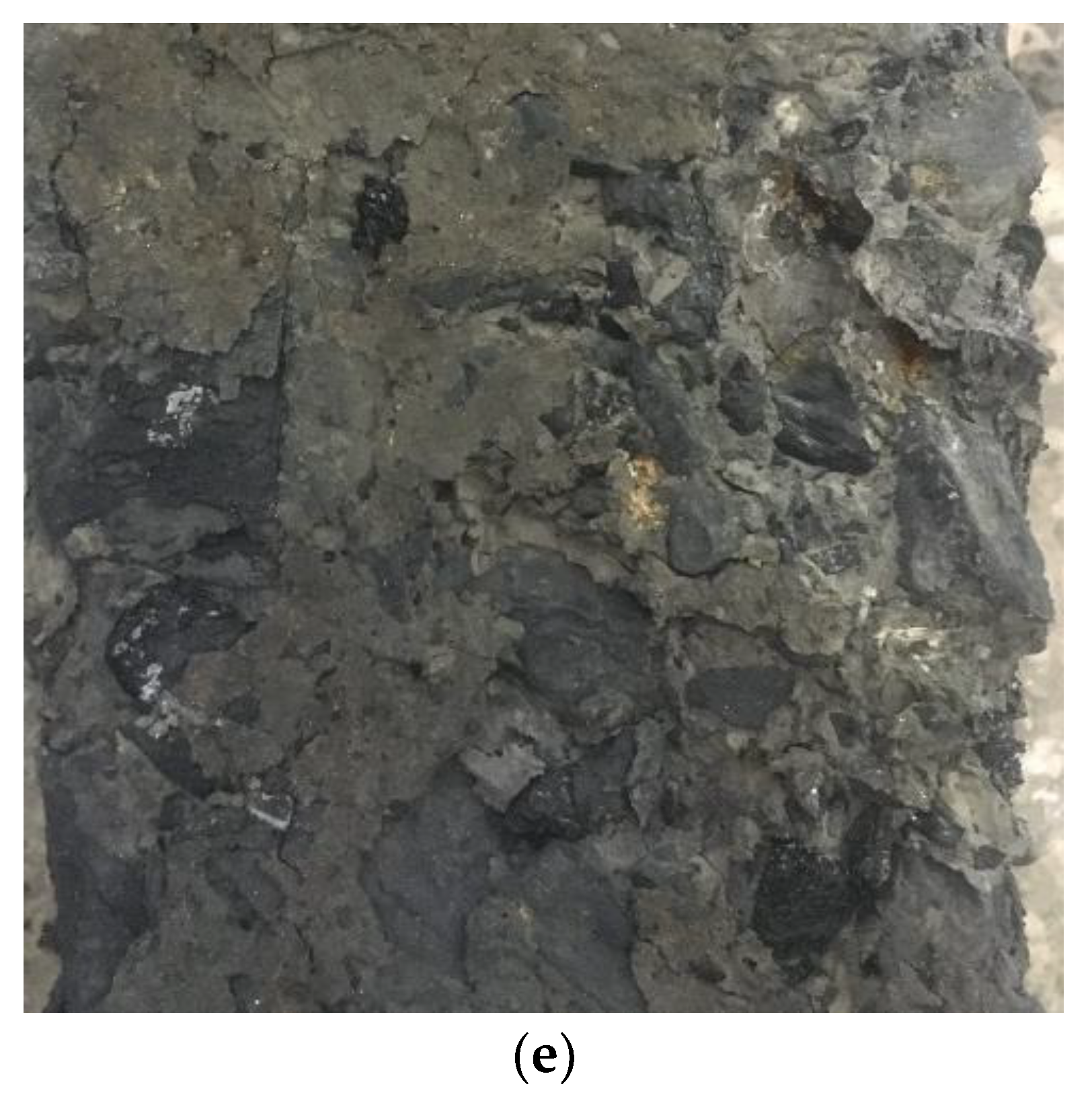
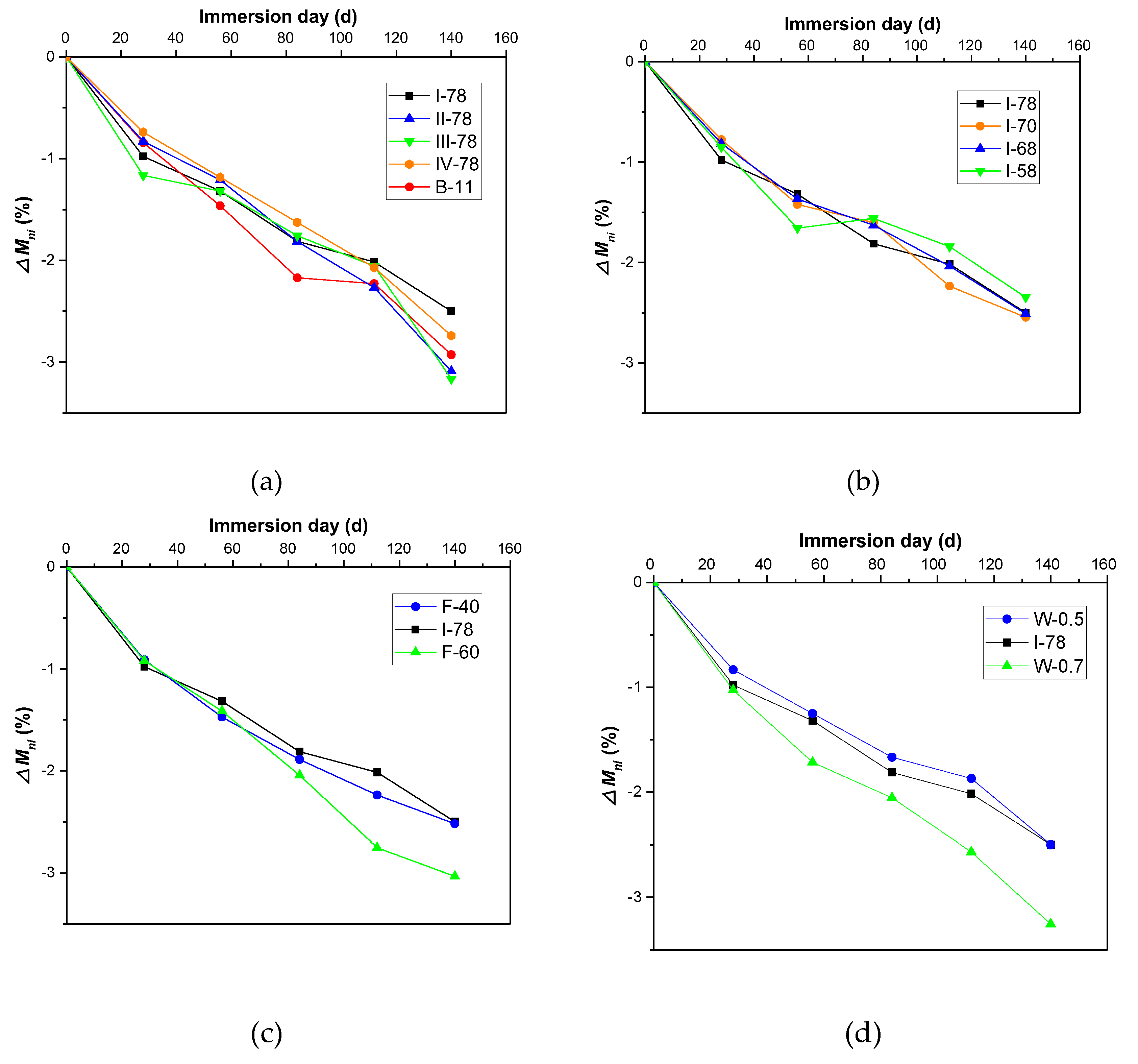
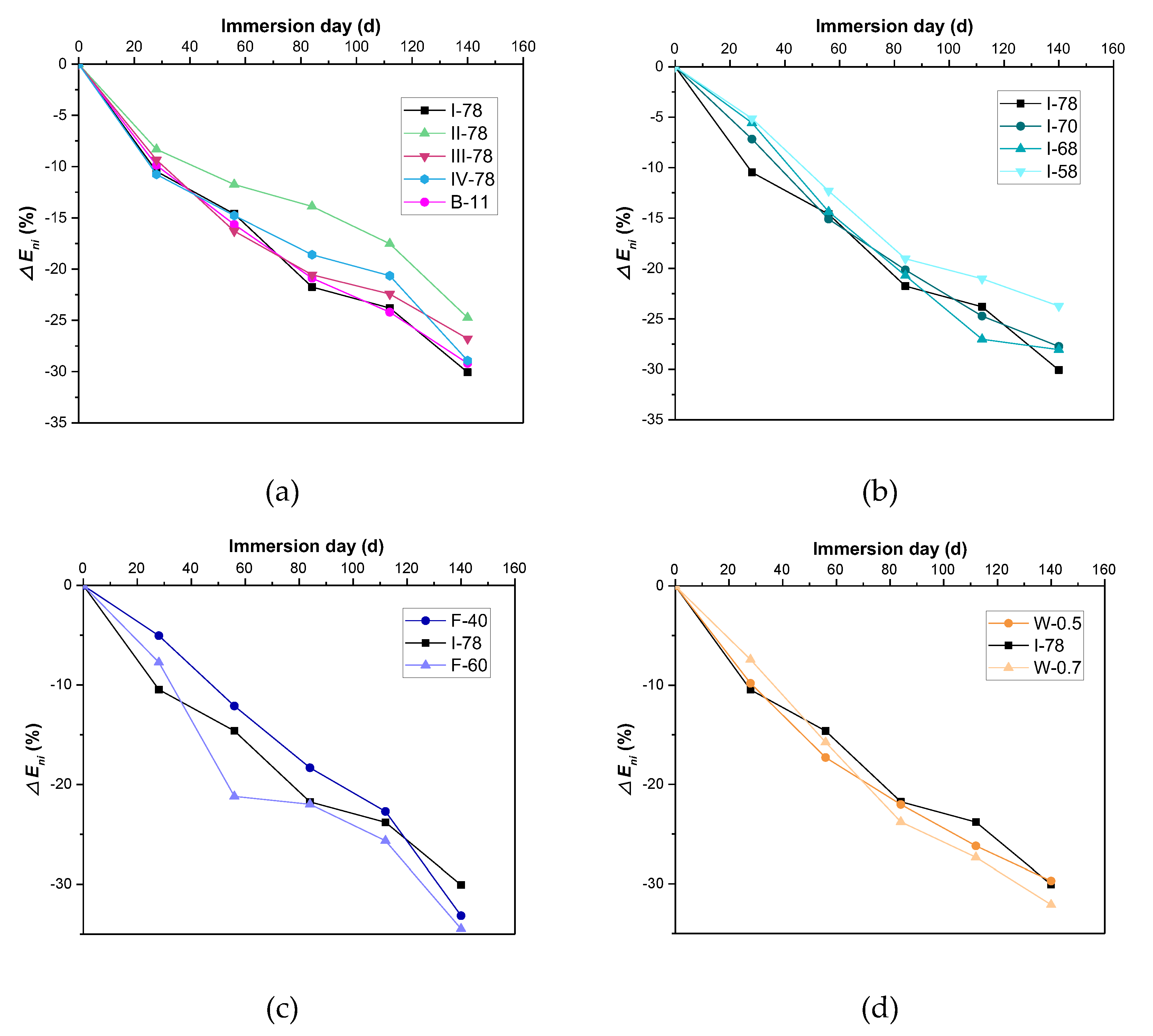

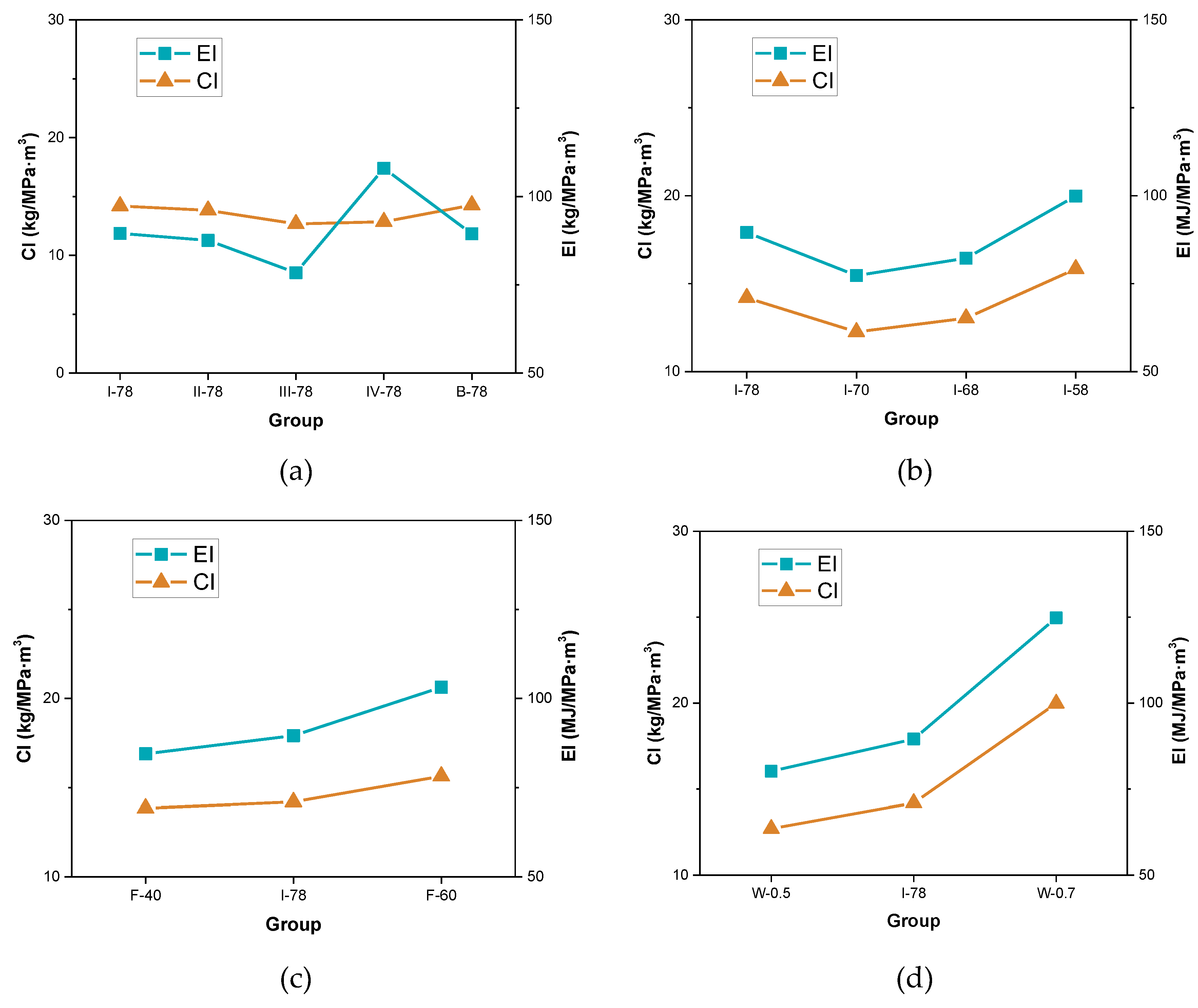
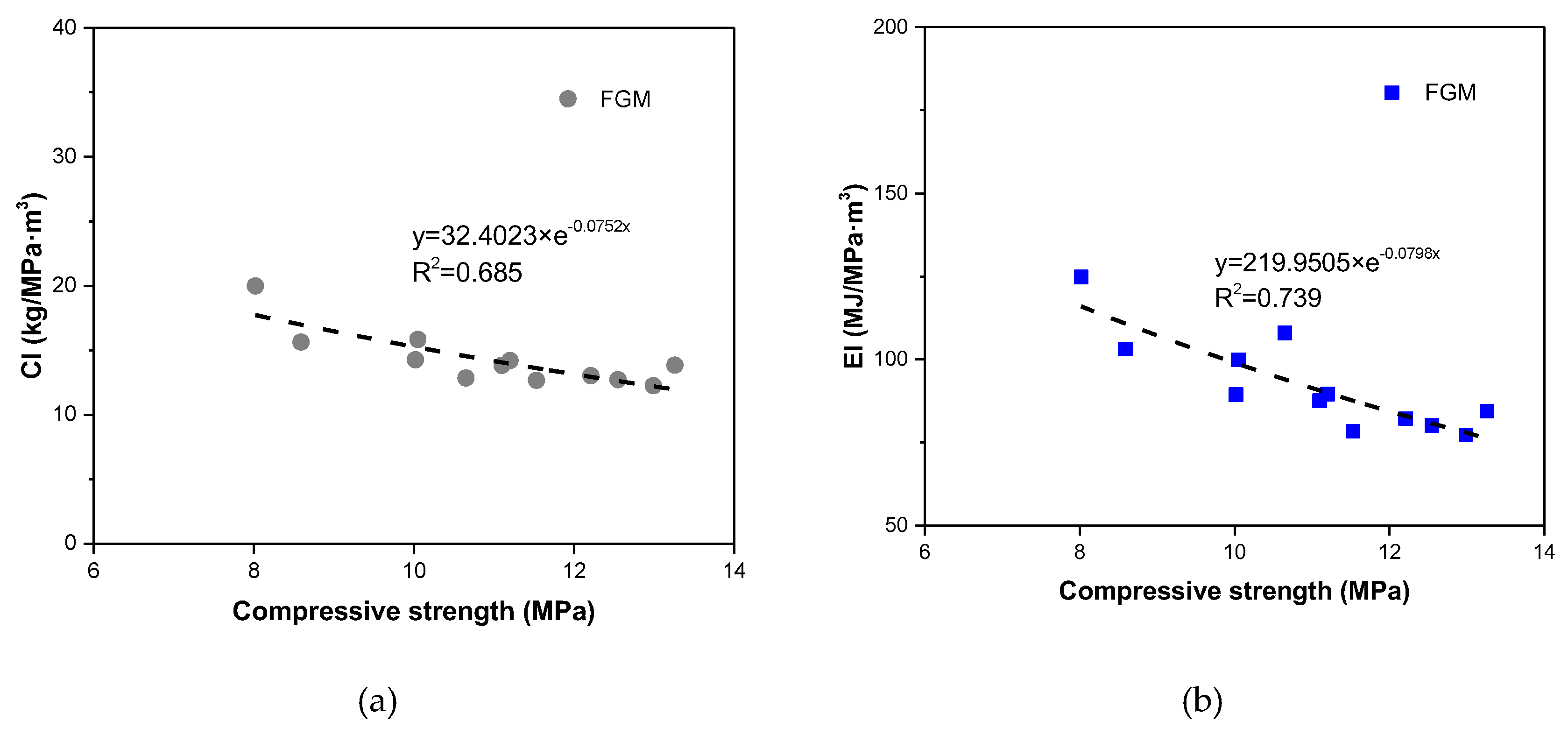
| Oxide | Cement | Fly ash | Coal Gangue I | Coal Gangue II | Coal Gangue III | Coal Gangue IV |
|---|---|---|---|---|---|---|
| Percent (%) | ||||||
| SiO2 | 22.37 | 53.10 | 57.71 | 60.19 | 61.05 | 65.87 |
| Al2O3 | 4.36 | 2.93 | 28.64 | 29.28 | 25.92 | 20.25 |
| Fe2O3 | 3.38 | 10.20 | 4.66 | 3.25 | 3.06 | 4.59 |
| CaO | 61.08 | 21.80 | 2.24 | 1.15 | 3.07 | 0.45 |
| MgO | 2.43 | - | 0.61 | 0.71 | 0.83 | 1.77 |
| SO3 | 2.45 | 0.58 | 0.80 | 0.44 | 0.20 | 0.20 |
| Na2Oeq | 0.51 | - | 0.58 | 0.21 | 0.61 | 1.98 |
| K2O | - | - | 2.99 | 3.07 | 3.67 | 3.98 |
| IL | 1.33 | 5.83 | - | - | - | - |
| Serials | Cement kg/m3 | Fly Ash kg/m3 | Coal Gangue (kg/m3) | Water kg/m3 | Coal Gangue Type | e-CO2 (kg/m3) | e-energy (MJ/m3) | |
|---|---|---|---|---|---|---|---|---|
| 0–4.75 mm | 4.75–31.5 mm | |||||||
| I-78 | 150 | 150 | 400 | 1440 | 180 | I | 158.97 | 1003 |
| II-78 | 150 | 150 | 400 | 1440 | 180 | II | 153.45 | 972 |
| III-78 | 150 | 150 | 400 | 1440 | 180 | III | 146.09 | 904 |
| IV-78 | 150 | 150 | 400 | 1440 | 180 | IV | 136.89 | 1150 |
| B-11 | 130 | 130 | 420 | 1460 | 180 | I | 142.91 | 896 |
| I-70 | 150 | 150 | 560 | 1280 | 180 | I | 158.97 | 1003 |
| I-68 | 150 | 150 | 590 | 1250 | 180 | I | 158.97 | 1003 |
| I-58 | 150 | 150 | 780 | 1060 | 180 | I | 158.97 | 1003 |
| F-40 | 180 | 120 | 400 | 1440 | 180 | I | 183.60 | 1120 |
| F-60 | 120 | 180 | 400 | 1440 | 180 | I | 134.34 | 886 |
| W-0.5 | 150 | 150 | 415 | 1455 | 150 | I | 159.51 | 1006 |
| W-0.7 | 150 | 150 | 485 | 1425 | 210 | I | 160.23 | 1001 |
| Items | e-CO2 | e-energy | References |
|---|---|---|---|
| Cement | 0.83 | 4.727 | [23,24] |
| Fly ash | 0.009 | 0.833 | [23,24] |
| Coal gangue I | 0.018 | 0.092 | [38] |
| Coal gangue II | 0.015 | 0.075 | [38] |
| Coal gangue III | 0.011 | 0.038 | [38] |
| Coal gangue IV | 0.006 | 0.172 | [38] |
| Limestone | 0.041 | 3.9 | [39,40] |
| No. of Specimen | Curing Ages (d) | Dynamic Electricity Modulus (GPa) | Dynamic Shear Modulus (GPa) | Poisson’s Ratio |
|---|---|---|---|---|
| I-78 | 28 | 14.8 | 4.9 | 0.510 |
| II-78 | 28 | 11.2 | 3.5 | 0.600 |
| III-78 | 28 | 10.5 | 3.4 | 0.544 |
| IV-78 | 28 | 10.7 | 3.5 | 0.528 |
| B-11 | 28 | 14.7 | 4.1 | 0.787 |
| I-70 | 28 | 15.2 | 5.2 | 0.472 |
| I-68 | 28 | 15.1 | 5.1 | 0.492 |
| I-58 | 28 | 14.2 | 4.6 | 0.542 |
| F-40 | 28 | 16.4 | 5.3 | 0.536 |
| F-60 | 28 | 14.3 | 4.6 | 0.552 |
| W-0.5 | 28 | 16.3 | 5.3 | 0.527 |
| W-0.7 | 28 | 13.2 | 4.5 | 0.478 |
| I-78 | 60 | 16.2 | 5.3 | 0.528 |
| II-78 | 60 | 13.2 | 4.2 | 0.581 |
| III-78 | 60 | 12.7 | 4.3 | 0.485 |
| IV-78 | 60 | 12.8 | 4.1 | 0.561 |
| B-11 | 60 | 15.1 | 4.2 | 0.779 |
| I-70 | 60 | 16.3 | 5.6 | 0.460 |
| I-68 | 60 | 16.0 | 5.3 | 0.499 |
| I-58 | 60 | 15.2 | 4.9 | 0.541 |
| F-40 | 60 | 17.8 | 5.8 | 0.542 |
| F-60 | 60 | 15.6 | 5.1 | 0.544 |
| W-0.5 | 60 | 17.7 | 5.8 | 0.532 |
| W-0.7 | 60 | 14.6 | 4.9 | 0.483 |
| No. of Specimen | Ascending Segment | Descending Segment | ||
|---|---|---|---|---|
| a | R2 | b | R2 | |
| I-78 | −1.14 | 0.98 | 12.79 | 0.99 |
| II-78 | −0.77 | 0.99 | 8.85 | 0.99 |
| III-78 | −0.90 | 0.98 | 11.19 | 0.97 |
| IV-78 | 0.49 | 0.99 | 9.35 | 0.99 |
| B-11 | −0.61 | 0.98 | 13.96 | 0.99 |
| I-70 | −1.88 | 0.94 | 30.46 | 0.99 |
| I-68 | −1.40 | 0.99 | 27.55 | 0.99 |
| I-58 | −0.04 | 0.99 | 5.99 | 0.98 |
| F-40 | −0.69 | 0.99 | 22.74 | 0.99 |
| F-60 | −0.88 | 0.99 | 4.91 | 0.98 |
| W-0.5 | −1.12 | 0.97 | 15.86 | 0.98 |
| W-0.7 | −1.31 | 0.99 | 7.71 | 0.98 |
© 2020 by the authors. Licensee MDPI, Basel, Switzerland. This article is an open access article distributed under the terms and conditions of the Creative Commons Attribution (CC BY) license (http://creativecommons.org/licenses/by/4.0/).
Share and Cite
Li, L.; Long, G.; Ma, K.; Ma, H.; Wang, W.; Zhang, C.; Xie, Y. Preparation of Green Low Strength Mixture for Foundation Reinforcement Treatment by Using Fly Ash and Waste Coal Gangue. Materials 2020, 13, 664. https://doi.org/10.3390/ma13030664
Li L, Long G, Ma K, Ma H, Wang W, Zhang C, Xie Y. Preparation of Green Low Strength Mixture for Foundation Reinforcement Treatment by Using Fly Ash and Waste Coal Gangue. Materials. 2020; 13(3):664. https://doi.org/10.3390/ma13030664
Chicago/Turabian StyleLi, Linhao, Guangcheng Long, Kunlin Ma, Hongwei Ma, Wenbing Wang, Cheng Zhang, and Youjun Xie. 2020. "Preparation of Green Low Strength Mixture for Foundation Reinforcement Treatment by Using Fly Ash and Waste Coal Gangue" Materials 13, no. 3: 664. https://doi.org/10.3390/ma13030664
APA StyleLi, L., Long, G., Ma, K., Ma, H., Wang, W., Zhang, C., & Xie, Y. (2020). Preparation of Green Low Strength Mixture for Foundation Reinforcement Treatment by Using Fly Ash and Waste Coal Gangue. Materials, 13(3), 664. https://doi.org/10.3390/ma13030664





